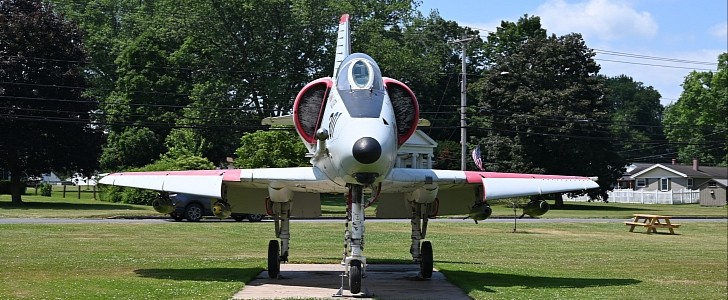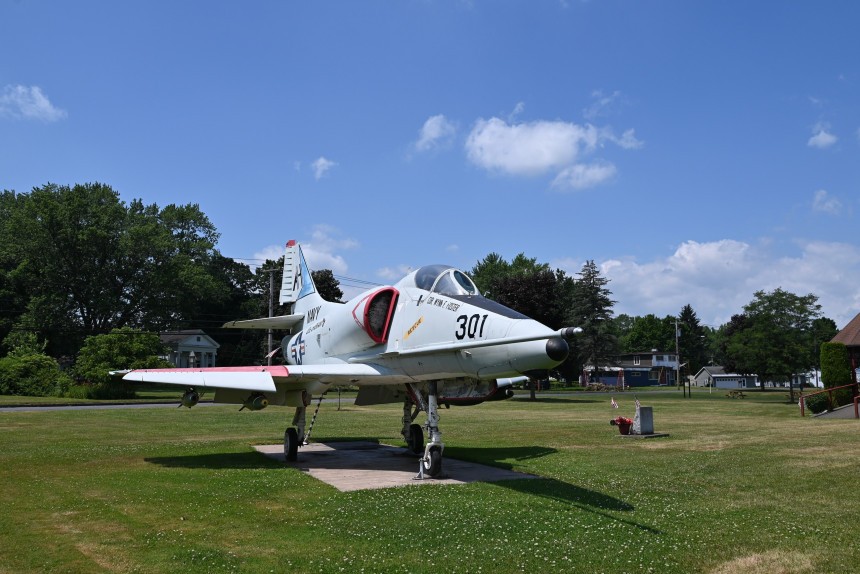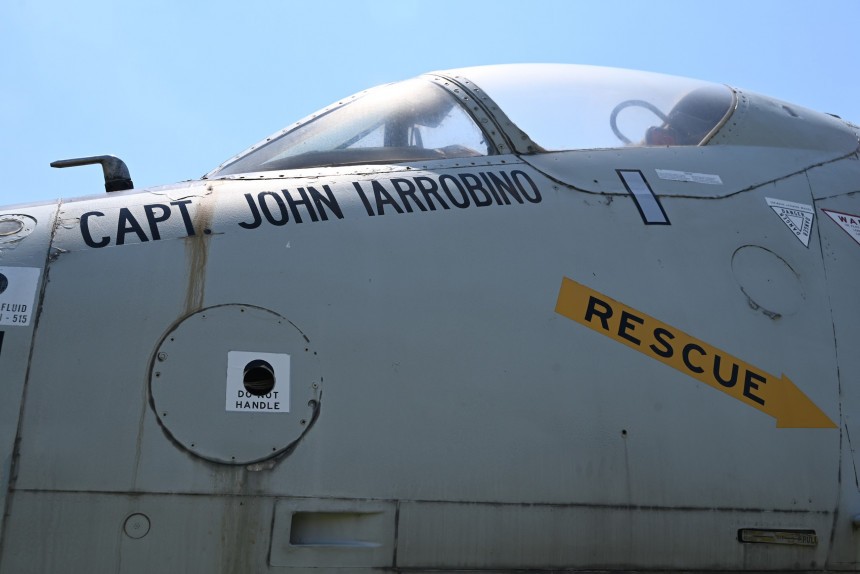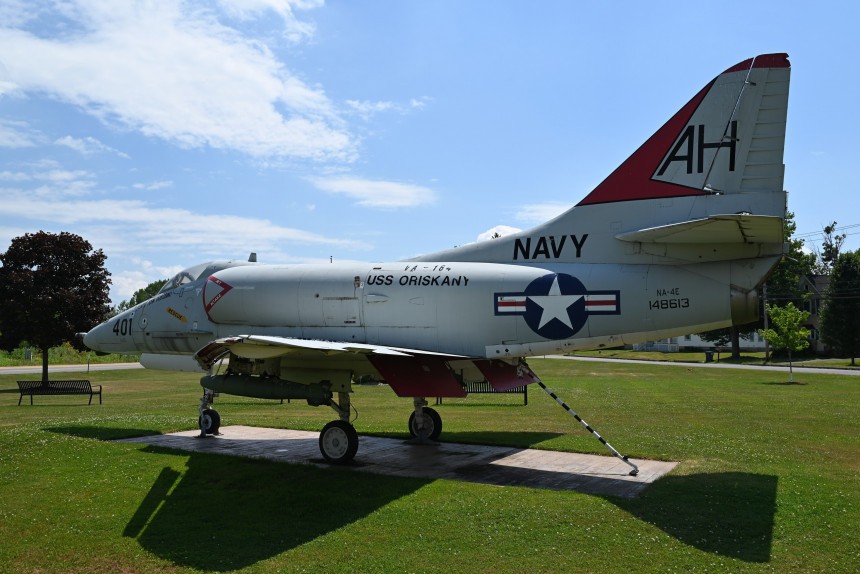The Douglas A-4 Skyhawk was the kind of attack airplane that comes along once, maybe twice in a generation. A deadly accurate ground attack jet with the room for many tons of ordinance under its wings pylons, while also light and agile enough to tussle against enemy fighters if needed.
The Skyhawk was sadly retired from U.S. Marine and Navy service in the late 90s and early 2000s, but there are places all across America and around the world where people can go and get an up-close look at them. Of all those displays, we can't help but think the most fitting and beautiful is found in the little town of Oriskany in Central New York.
Here, a derelict A4E Skyhawk plays the role of watchdog over the larger USS Oriskany Memorial Park. A small public playground, part-time museum, and war memorial dedicated to the men and women who served aboard the aircraft carrier USS Oriskany. A vessel that the Skyhawk was intimately familiar with. The Skyhawk.
So while we marvel at high-res photos of this stunning airplane, let's take a trip back in time to explore the story behind one of the Vietnam War's most iconic jets. The Douglas Skyhawk's history is irreversibly connected to that of its predecessor, the piston-engine powered A-1 Skyraider. Designed by Douglas engineer Ed Heinemann, the Skyraiders successor needed to be lightweight, jet-powered, and capable of carrying a wide array of ground ordinance into battle at high subsonic speeds.
The end result was an airframe less than five US tons (4.5 metric tons) in weight and with a wingspan well under 30 feet (9.1 m). Such a design was especially enticing to the United States Navy and Marine Corps, who were still largely using older aircraft carriers of Second World War vintage. With antiquated hydraulic aircraft catapults, the lightweight Skyhawk was all too perfect for their purposes.
With a single General Electric Pratt & Whitney J52-P-6A turbojet cranking 8,500 lbf (38 kN) of thrust each in the A4E on display at Oriskany, the Skyhawk was the king of STOL jets before they were cool. Because most American World War II era carriers couldn't launch larger fighters like the F-4 Phantom II and A-7 Corsair, the Navy especially began to fall in love with the Skyhawk, which had its name changed from the A4D to the A-4 with the US Navy's new nomenclature in 1962.
To save weight and money, early Skyhawks lacked a dedicated radar system. Not ideal for air-to-air combat. But then again, that didn't stop Douglass from fitting them with early variants of the Aim-9 Sidewinder infrared air-to-air missiles and twin Colt Mk12 20 mm cannons just in case a MiG decided to pull up into enemy airspace.
The Skyhawk could also carry anywhere between 8,000 and 10,000 pounds (3,628.7 to 4,535.9 kg) of bombs under its wings between its older and newer variants. For some context, that's roughly the same as the maximum bomb load of a B-17 Flying Fortress heavy bomber from World War II. If you're curious, yes, that also includes nuclear payloads. Platform upgrades added features like air-to-air refueling capabilities with the A-4B and its own dedicated radar with the A-4C.
Suddenly, the Skyhawk was also a fearsomely capable night flyer on top of its other innate virtues of being a capable ground attack jet. All qualities that would be of great benefit to Skyhawk pilots over the skies of North Vietnam. No sooner was the first shots fired between North Vietnamese torpedo boats and US Navy Forces before President Lyndon B. Johnson called in the first airstrikes against North Vietnamese Naval assets on August 5th, 1964.
Of course, the airplanes to make these first raids were none other than A4 Skyhawks carrying Rockeye-II Mark 20 Cluster Bombs, Mark 82 500 lb (226.8 kg) bombs, and armor penetrating 20mm cannon fire. It was the first in a series of thousands of sorties the Skyhawk would fly during the conflict. The type continued to serve with the U.S. Marine Corps until 1998 and with the Navy until 2007.
Outside of American service, the Skyhawk served in armed forces across the globe in places like Argentina, Australia, New Zealand, Kuwait, Indonesia, Brazil, and Israel. During Operation Desert Storm, the Skyhawk was one of the few Kuwaiti Air Force jets left in the sky after the initial invasion by Sadam Husein's Iraq. It was also the preferred target practice tool of TOP-GUN. The real thing, not the movie.
So then, it makes sense why Skyhawks are still adored and on display around the world. This particular A4E here in Oriskany Memorial Park was a part of the same squadron aboard the USS Oriskany with which future Presidential candidate John McCain would serve with in Vietnam.
There are even a couple of Mark 82 unguided bombs mounted underneath each wing. Though, of course, this jet could carry a heck of a lot more than that load in a combat situation. It doesn't make the thing any less nice to look at.
Check out more military airplane profiles and so much more right here on autoevolution.
Here, a derelict A4E Skyhawk plays the role of watchdog over the larger USS Oriskany Memorial Park. A small public playground, part-time museum, and war memorial dedicated to the men and women who served aboard the aircraft carrier USS Oriskany. A vessel that the Skyhawk was intimately familiar with. The Skyhawk.
So while we marvel at high-res photos of this stunning airplane, let's take a trip back in time to explore the story behind one of the Vietnam War's most iconic jets. The Douglas Skyhawk's history is irreversibly connected to that of its predecessor, the piston-engine powered A-1 Skyraider. Designed by Douglas engineer Ed Heinemann, the Skyraiders successor needed to be lightweight, jet-powered, and capable of carrying a wide array of ground ordinance into battle at high subsonic speeds.
The end result was an airframe less than five US tons (4.5 metric tons) in weight and with a wingspan well under 30 feet (9.1 m). Such a design was especially enticing to the United States Navy and Marine Corps, who were still largely using older aircraft carriers of Second World War vintage. With antiquated hydraulic aircraft catapults, the lightweight Skyhawk was all too perfect for their purposes.
To save weight and money, early Skyhawks lacked a dedicated radar system. Not ideal for air-to-air combat. But then again, that didn't stop Douglass from fitting them with early variants of the Aim-9 Sidewinder infrared air-to-air missiles and twin Colt Mk12 20 mm cannons just in case a MiG decided to pull up into enemy airspace.
The Skyhawk could also carry anywhere between 8,000 and 10,000 pounds (3,628.7 to 4,535.9 kg) of bombs under its wings between its older and newer variants. For some context, that's roughly the same as the maximum bomb load of a B-17 Flying Fortress heavy bomber from World War II. If you're curious, yes, that also includes nuclear payloads. Platform upgrades added features like air-to-air refueling capabilities with the A-4B and its own dedicated radar with the A-4C.
Suddenly, the Skyhawk was also a fearsomely capable night flyer on top of its other innate virtues of being a capable ground attack jet. All qualities that would be of great benefit to Skyhawk pilots over the skies of North Vietnam. No sooner was the first shots fired between North Vietnamese torpedo boats and US Navy Forces before President Lyndon B. Johnson called in the first airstrikes against North Vietnamese Naval assets on August 5th, 1964.
Outside of American service, the Skyhawk served in armed forces across the globe in places like Argentina, Australia, New Zealand, Kuwait, Indonesia, Brazil, and Israel. During Operation Desert Storm, the Skyhawk was one of the few Kuwaiti Air Force jets left in the sky after the initial invasion by Sadam Husein's Iraq. It was also the preferred target practice tool of TOP-GUN. The real thing, not the movie.
So then, it makes sense why Skyhawks are still adored and on display around the world. This particular A4E here in Oriskany Memorial Park was a part of the same squadron aboard the USS Oriskany with which future Presidential candidate John McCain would serve with in Vietnam.
There are even a couple of Mark 82 unguided bombs mounted underneath each wing. Though, of course, this jet could carry a heck of a lot more than that load in a combat situation. It doesn't make the thing any less nice to look at.
Check out more military airplane profiles and so much more right here on autoevolution.



















